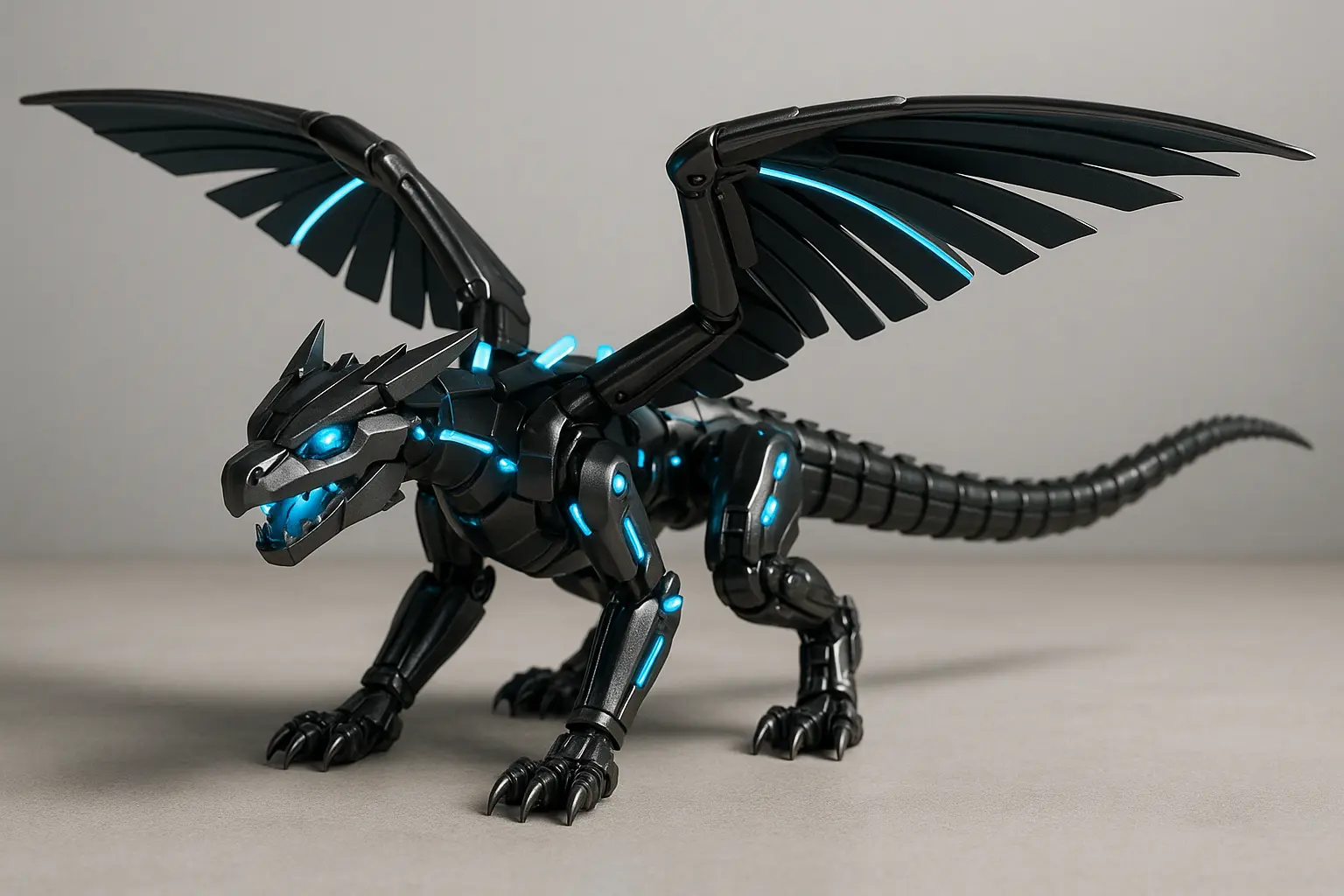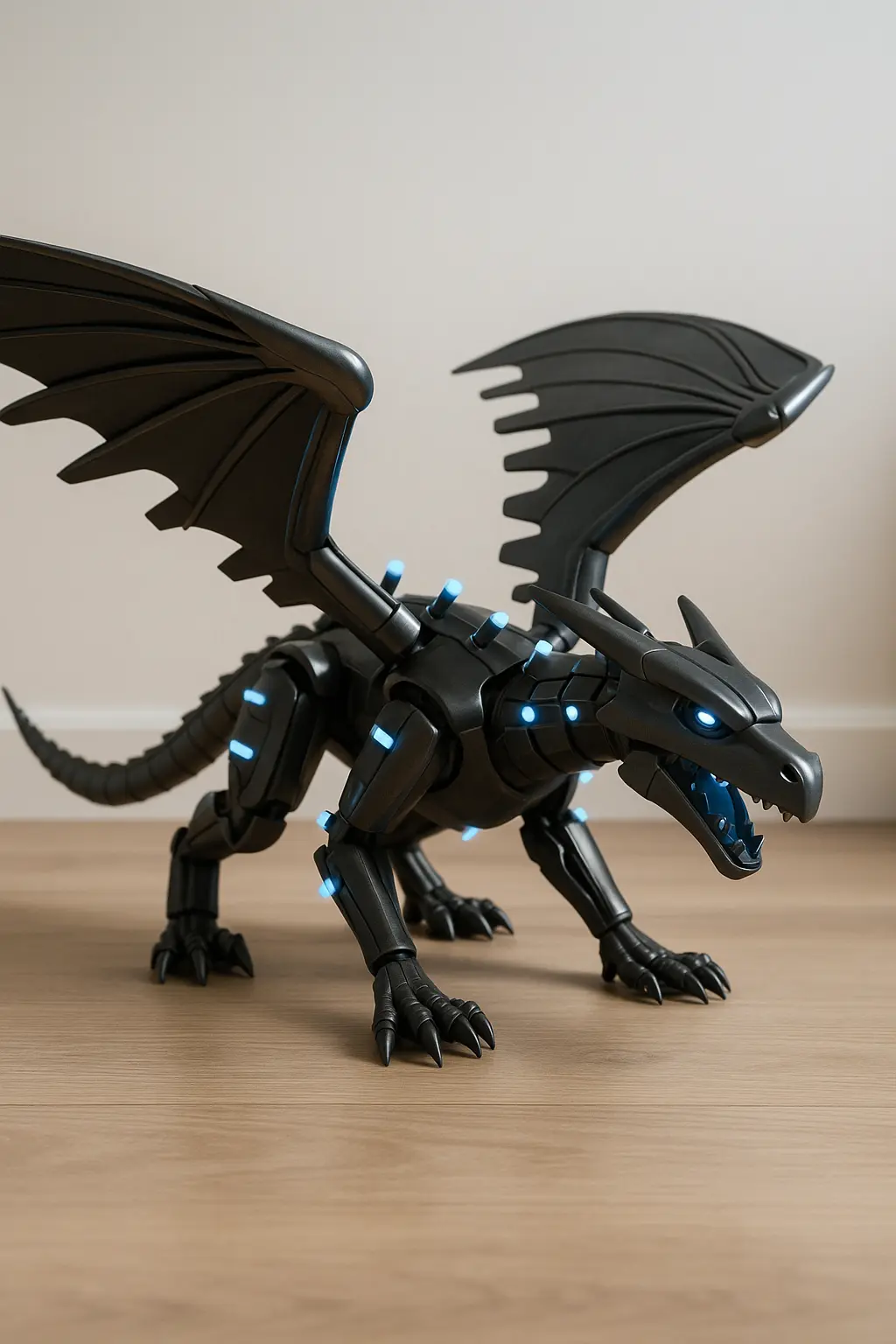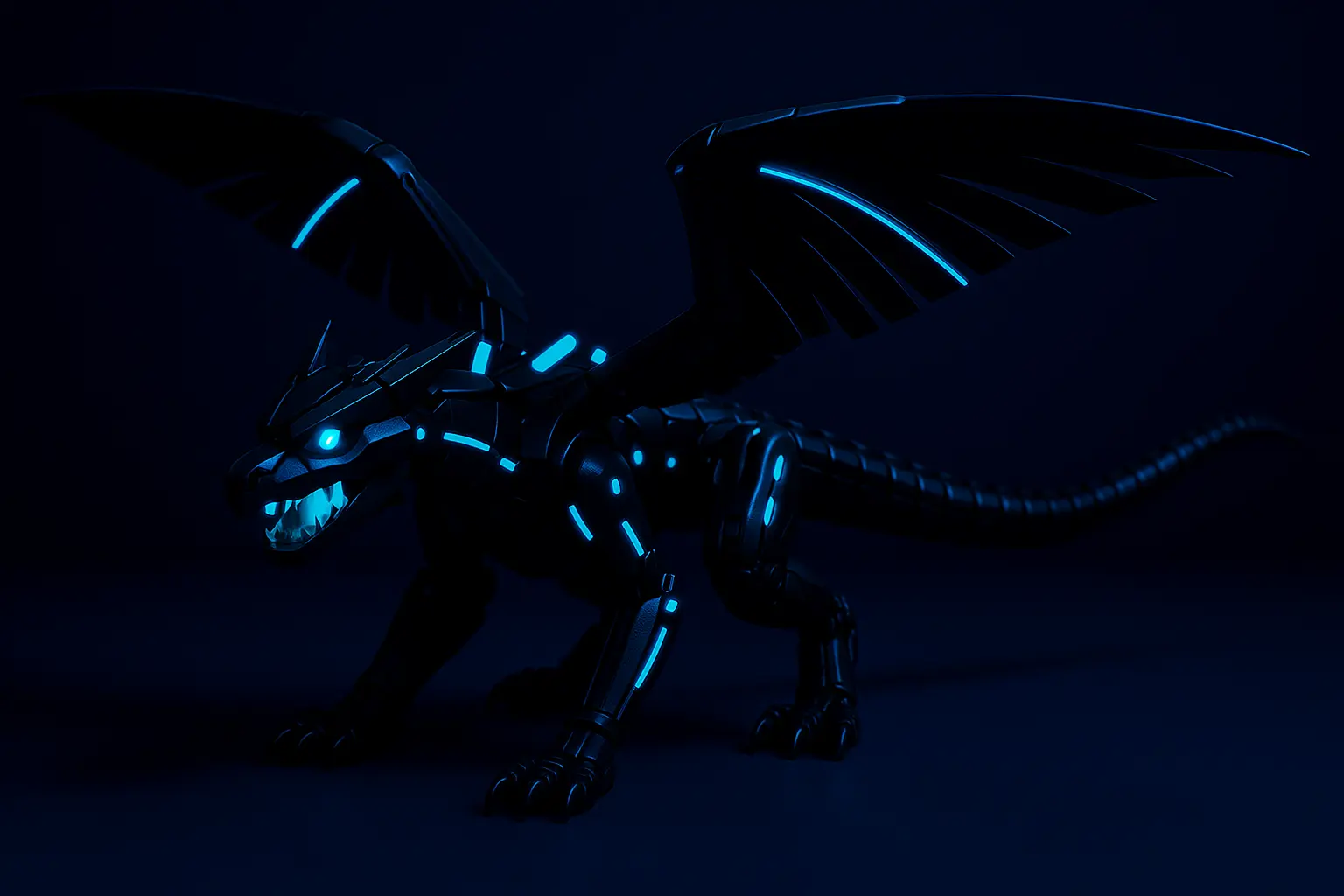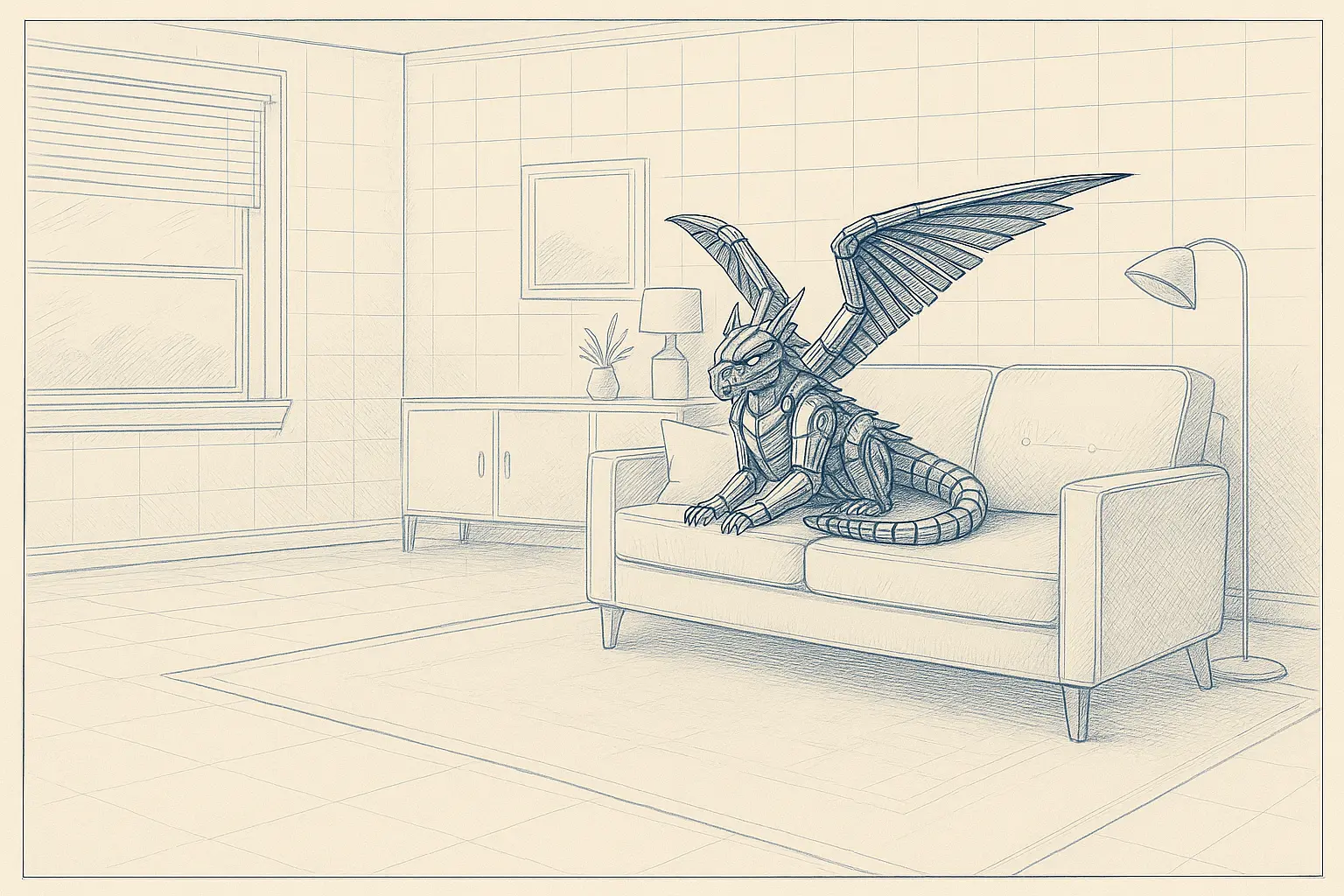Blue Dragon Owner’s Manual

About This Instruction Manual
Other Documentation for This Product
This manual describes the setup and operation of your Blue Dragon.
- Information about product accessories (DragonWare™) can be found in the Owner’s manual provided with these accessories.
- For warranty and product return information, please refer to the Dragon Lair support site.
Special Features in This Web Manual
Using the following features requires that you use the online version of this manual. They may not work if you download the manual.
Indexing Tools
This manual has a table of contents in the sidebar and dynamically generated lists of images and tables.
Dynamic Glossary
Clicking on terms linked to the glossary will load the glossary term directly into the current document. Try it here with the link to the dragon entry.
Other Versions of This Manual
There is also a downloadable and printable version of this manual in PDF format. Find it here.
You can also print this manual from your browser or use your web browser’s “Save as PDF” feature to save a self-contained copy. The output quality, format, and other factors depend on your web browser’s capabilities and your printer. If your system’s preinter driver supports it, you can also print just selected pages.
There is also a chapter-sized version of this manual at dragonlair.specs-and-docs.online/dragonlair_blue_dragon_manual_english/
Symbols and Typographic Conventions
The following symbols and typographic conventions are used in this manual.
 – A black dragon head icon is intended to alert the user to the presence of important operating and maintenance (servicing) instructions in the literature accompanying the product.
– A black dragon head icon is intended to alert the user to the presence of important operating and maintenance (servicing) instructions in the literature accompanying the product.
 – A red dragon head icon is intended to alert the user to a potentially hazardous situation which, if not avoided, can result in damage or destruction of the product described in this manual or other property.
– A red dragon head icon is intended to alert the user to a potentially hazardous situation which, if not avoided, can result in damage or destruction of the product described in this manual or other property.
 – The exclamation point within a red, equilateral triangle is intended to alert the user to a potentially hazardous situation which, if not avoided, can result in personal injury.
– The exclamation point within a red, equilateral triangle is intended to alert the user to a potentially hazardous situation which, if not avoided, can result in personal injury.
 – The dragon wings icon highlights information relating to flight. When flying your Dragon, be sure to follow all regional guidelines and laws pertaining to autonomous and remotely controlled flying toys and airplane models.
– The dragon wings icon highlights information relating to flight. When flying your Dragon, be sure to follow all regional guidelines and laws pertaining to autonomous and remotely controlled flying toys and airplane models.
1. Introduction
“Do not meddle in the affairs of dragons, for you are crunchy and taste good with ketchup.”
– Unknown
Congratulations, Dragon Tamer!

There are many dragons in the world. Some roam free, some don’t. Some are friendly, others not so much.
But this Dragon is yours, and the way you treat it will have a big effect on what it will become.
Whatever your plans are, be sure to read these instructions – they will ensure no harm comes to you or your new companion.
Thank you.
2. Important Safety Instructions
- Read these instructions.
- Keep these instructions.
- Heed all warnings.
- Follow all instructions.
- Do not use your dragon near water.
- Clean only with a dry cloth. Dragons may look rough, but they appreciate a soft touch.
- Do not block your Dragon’s nostrils.
- Do not let your Dragon sit near heat sources such as radiators, heat registers, stoves, or other apparatus that produce heat.
 Do not step on your Dragon’s tail.
Do not step on your Dragon’s tail.
Dragons can get enormously angry when someone steps on their tail, which may result in hissing and small outbursts of fire.- Protect your Dragon’s tail from being walked on or pinched in any way by guests, small children, pets, and other creatures. Just in case we haven’t made it abundantly clear: It is never, ever a good idea to step on a Dragon’s tail.
- Only use harnesses and accessories specified by Dragon Lair A/S or the authorized Dragon Lair A/S distributor in your region.
- Make sure your Dragon is inside the house during lightning storms. While most Dragons usually won’t take damage when hit by lightning, it tends to have an electrifying effect on their characters, and they can be moody for several days.
- Refer all Dragon servicing to qualified service personnel. Servicing is required when your Dragon has been damaged in any way, is not responsive to stimuli, or is in a foul mood for a period of three days or longer.
3. Getting to know your Dragon
In this section of the Blue Dragon manual, we’ll be taking a closer look at some of your Dragon’s components and features. Click or tap on a feature to learn more about it.

Visor
Your Blue Dragon is equipped with a powerful Visor system based on bleeding-edge image detection systems and neural processing networks.
Wings
Your Blue Dragon has two beautiful anthracite-colored wings that generate powerful lift, enough to allow your Dragon to take off even from narrow ledges or kitchen counter tops. These wings are covered with tiny, scale-shaped solar cells that supply additional energy on sunny days, allowing for prolonged flight. However, they are not sufficient to power your Dragon when its main power supply is exhausted. The wings’ tips are lined with blue LEDs that make it easier to detect your Dragon during night flight.
Forefeet
Your Blue Dragon’s forefeet have four toes with short, retractable talons.
The talons are usually retracted, but will automatically be extended when your Dragon needs to balance on uneven surfaces.
Avoid making your Blue Dragon land on or lift off from surfaces covered in delicate cloth or Brussels lace. Your Dragon will suffer no damage, but your relationship with the owner of these items might.
Front Legs
Your Blue Dragon’s front legs are used both for walking and holding/manipulating small objects.
Rear Legs
Your Blue Dragon has very powerful rear legs. They provide the necessary energy for jump lift-off from most solid surfaces. Your Dragon can take flight from soft surfaces such as pillows, but it will require significantly more vortex drag.
Hind Feet
The hind feet, just like the forefeet, provide a firm grip on most even surfaces. However, your dragon may slip on very plain, wet surfaces.
Neck
Your Blue Dragon has an extendable neck composed of four cones. In Sleep Mode, the neck will automatically be retracted. In Flight Mode, the neck will be fully extended to improve orientation and allow for more complex flight maneuvers.
Tail
In case we haven’t mentioned this before: Never, ever step on your Dragon’s tails. You might lose your warranty (or other things that are dear to you).
That being said, a Dragon’s tail is a valuable status generator. Here are some useful tail-based status messages:
| Tail Movement | Meaning |
|---|---|
| Wagging / slow | Your Dragon notices that you are present and awaits commands or suggestions. |
| Wagging / fast | Pre-flight adjustment. Your dragon is about to take off. |
| Tail goes up quickly, then slowly descends | Watch Mode activated. The video signal from your Blue Dragon’s visor is streamed to a video monitor in another room. Tail movements notify people present in the room that your Dragon is watching them. This Watch Mode alert is legally required and cannot be switched off to prevent unlawful monitoring of people. Use Watch Mode only to monitor babies or pets. |
| Tail down between legs | Something is wrong. This may indicate low battery status, the inability to fulfill a request, or a sign of insufficient stimulus, also known as boredom. |
4. Setting Up Your Dragon

Be careful when setting up your dragon.
Do it right, and you’ll be awarded with hours, days, and years of fun.
However, if you’re sloppy, your Dragon might be… upset.
Unpacking
Your Dragon comes wrapped in a fireproof, dark grey cloth.
Carefully unwrap your Dragon, set it on a plain surface in a well-lit room, and step back a little.
After a few minutes, your Dragon’s wings should start to unfold, and he will begin to move his neck and tail. During this calibration and adjustment phase, you should not move or push your Dragon, as it might affect calibration results.
(That being said, pushing Dragons is never a good idea to begin with.)
If your Dragon ends calibration by lying down and covering his head with his front paws, something went wrong. In that case, please cover your Dragon’s head with the cloth and wait an hour or two, then try again.
 WARNING
WARNING
Never calibrate a freshly purchased Dragon after midnight. You have been warned.
5. Dragon Flight
All information about flight procedures in this manual is accompanied by this symbol:
 FLIGHT
FLIGHT
Preparing Indoor Flights
Indoor flights require a room with the following dimensions:
- Width / Depth
-
4 m (13 ft) or more
- Height
-
2.5 m (8.2 ft) or more
Indoor Flights
Here is how to get your Dragon to fly indoors:
- Place your Dragon on a flat surface. A table is ideal.
- Step back; at least 2 meters / 6 feet.
- Wave your arms and/or say “Fly, boy!”. Your Dragon should take flight after a few seconds.
Preparing Outdoor Flights
You can let your Dragon fly outside as long as the following conditions are met:
- Temperatures between -10° C and 40° C
- Wind speeds not higher than 50 km/h / 31 mph / 6 Beaufort
 WARNING
WARNING
Never let your Dragon fly near airports or spaceports. Even if you can get it to take off (which is very unlikely due to safety features built both into your Dragon and the airport/spaceport security systems), an airborne Dragon might be attacked by the RoboHawks™ securing the perimeter of the airport/spaceport.
Outdoor Flights
- Place your Dragon on a flat surface. Avoid takeoffs from high grass.
- Step back; at least 2 meters / 6 feet.
- Wave your arms and/or say “Fly, boy!”. Your Dragon should take flight after a few seconds.
Please note that your Dragon will not take off when there are objects that could be damaged or sent flying through the air by the air drag its wings generate. When you urge him to fly, he will just shake his head and make a noise not unlike a horse neighing. In this case, point to a location better suited for liftoff and say “Go there, boy”.
Instructional Flight Videos
Arena Flight
The following video shows a military-grade full-size Dragon during flight training. While your Blue Dragon is smaller and less powerful, the basic principles are the same.
Outdoor Flight
Here is another video showing a full-size Dragon with a few smaller Dragons during open space flight training.
6. Software Upgrades
Your Dragon will usually self-update its software during setup and overnight. However, in certain situations, an automatic update may have failed. In this case, you can use shell access to update your Dragon’s Operating System and Neural Network.
Updating the Core Software
- Open a terminal on your computer, tablet, or smartphone.
- Type the following commands (and a carriage return after each command):
get dblue
dblue authenticate
dblue upgrade - If there is more than one Dragon in the vicinity, you will be asked for its name. Enter your Dragon’s name.
- You will be asked for your Dragon’s password. Enter your Dragon’s password.
- The dblue application will now download the most recent DOS version and transfer it to your Dragon. Do not move your Dragon outside of your WiFi network’s range during the update procedure.
Optional Software
You can upgrade and extend your Dragon’s software to enable additional features. Here is a list of currently available software components.
 Features with this symbol require a subscription to the Dragon Cloud Club.
Features with this symbol require a subscription to the Dragon Cloud Club.
- Sharp Turn – Enhance your Dragon’s flight capabilities. With Sharp Turn, your Dragon will add some impressive maneuvers to his flight repertoire, such as near-ground flight, inside loops, and yes, very sharp in-flight turns that would make a crow green with envy.
- Night Vision Plus™ – Enhance your Dragon’s night vision capabilities. Night Vision Plus™ allows your Dragon to identify you and your family members and move around in low-light situations (from 0.8 candela).
- Night Watch – When your family goes to bed, have your Dragon watch over the house. Will detect unusual movements and noises. Night Watch requires the Night Vision package.

Before installing optional software components, you should upgrade your Dragon’s Operating System (DOS) to the most recent version. You will usually be informed about version issues, but it’s always a good idea to keep your Dragon up-to-date.

7. Troubleshooting
We know, we know: Sometimes, bad things happen to good dragons.
Let us help!
| What seems to be the matter, dear? | Possible Cause | Remedy |
|---|---|---|
| Problem: Dragon won’t wake up. | Possible cause: Batteries drained | Solution: Take your Dragon to its PowerMat. Set him down (gently) and let him rest for an hour or longer. |
| Problem: Dragon won’t wake up. | Possible cause: Deep Sleep | Solution: Your Dragon goes into Deep Sleep when downloading a firmware update or recalibrating his neural network. Let him rest and wait until the procedure is finished. |
| Problem: Dragon is in a grumpy mood and won’t fly. | Possible cause: Interaction Deficit Disorder | Solution: Your Dragon’s Neural Network requires stimulus to stay operational and maintain its ability to learn and adapt. Keeping a Blue Dragon activated, but not interacting with it will lead to negative feedback loops. If you keep your Blue Dragon activated, be sure to interact with it. Talking to your Dragon, giving commands and asking questions should soon restore its regular, attentive, and curious state. |
| Problem: Dragon is in a highly grumpy mood and hisses when you try to touch him. | Possible cause: Your Dragon may suffer from Neural Network Negative Feedback Disorder (N3FD) | Solution: N3FD is a non-trivial malfunction requiring servicing. Please get in touch with technical support as soon as possible. |
8. Technical Specifications
Please note that all specifications are subject to change without further notice.
| Parameter | Value | Remarks |
|---|---|---|
| Weight | 2.5 kg / 5.5 lbs | Net weight |
| Dimensions – W x H x D (Sleep / Curled Position) | 400 x 250 x 450 mm | Curled Position only achieved when Dragon is fully asleep. |
| Dimensions – W x H x D (Fully awake) | 1100 x 450 x 900 mm | Width from wingtip to wingtip / Length from nose to tail |
| Core Processor | MageTech X3, 16 GHz | |
| Main Visual Processor | LightLogix Blue Star 020, 32 GHz | |
| Operating System | Dragon Operating System (DOS) Version 2.5 or higher | For DOS updates, see the Software Upgrades section of this manual. |
| Neural Network | Neurotica Version 3.0 or higher | Please note that Neural Network updates require the latest DOS version. See the Software Upgrades section of this manual. |
| Battery | BlueCore 3rd generation Lithium-Ion Battery, 800 W, 1200 Load Cycles |
Appendix 1: Dragon Glossary
This section provides valuable background information on dragons.
Dragon
A dragon is a large, serpent-like legendary creature that appears in the folkloreof many cultures around the world. Beliefs about dragons vary drastically by region, but dragons in western cultures since the High Middle Ages have often been depicted as winged, horned, four-legged, and capable of breathing fire. Dragons in eastern cultures are usually depicted as wingless, four-legged, serpentine creatures with above-average intelligence.
Glaurung
Glaurung, first introduced in The Silmarillion, is described as the Father of Dragons in Tolkien’s legendarium, and the first of the Urulóki, the Fire-drakes of Angband. He is a main antagonist in The Children of Húrin, in which he sets in motion events that bring about the protagonist Túrin’s eventual suicide before being slain by him. He is described as having four legs and the ability to breathe fire, but no wings.
Night Fury
The Night Fury is a Strike Class dragon that first appeared in the film adaptation of How to Train Your Dragon book series. It is formerly described as the Unholy Offspring of Lightning and Death Itself. So far, the only known Night Fury in the franchise is Toothless. The Night Fury is a close relative of the Light Fury, the latter being a variation of the former.
Smaug
Smaug is a fictional character and the primary antagonist in J. R. R. Tolkien’s 1937 novel The Hobbit. He is a powerful, fearsome dragon who invaded the Dwarf kingdom of Erebor 150 years before the events described in the novel. A group of thirteen dwarves mounted a quest to take the kingdom back, aided by the wizard Gandalf and the hobbit Bilbo Baggins. Smaug is described as a most specially greedy, strong and wicked worm.
Appendix 2: Index of Images and Tables in This Manual
List of Tables in This Manual
List of Images in This Manual
Appendix 3: About The Blue Dragon Manual

Much to our regret, the Blue Dragon companion described in this manual does not exist.
Actually, this document is a showcase for the LOOPS publishing workflow developed by 9to5 Media Services.
(Yes, it’s an acronym. LOOPS stands for “Lightweight Object-Oriented Publishing System”.)
Audience
Our target group for this document is potential customers who are interested in a modern, web/mobile-focused publishing workflow. In particular:
- Documentation Teams
- Technical writers
- Language Service Providers
Concepts and Technologies demonstrated in this manual
Here is a list of the technologies we are showcasing with this document.
Content Creation – Basic Features
- Document creation from lightweight markup language source files
- Pure HTML5-based product manuals using semantic Markup
- Tag structure for search engine optimization and assistive technology
- Variables
Presentation Customization
- Responsive Markup – adjustment to devices/viewports
- Styles / Style Sheets for screen + paged media
Content Creation – Text Markup Features
- Typography (font + style specification)
- Definitions
- Emphasis / Strong Emphasis
- Headlines
- Lists (ordered and unordered)
- Paragraphs
- (Preservation of) program code and markup
- Quotes
- Complex Tables with headers, footers, and captions
- Mobile-friendly (collapsing tables) on mobile devices
Content Creation – Media integration
- Images (transcluded/embedded locally)
- Semantic Icons
- Image maps with in-document links
- Video playback – local (M4V)
- Video playback – web (Vimeo, YouTube)
Navigation, customization + discovery
- Table of contents
- Link target highlighting animation
- Links
- Automatically generated table of contents, images, and table lists for the current document (JavaScript feature)
Publishing / Export
- Capsulation – PDF Export (using the Prince XML renderer)
Designed, engineered, and assembled in Norway
Dragon Lair A/S
5007 Bergen
Norway
Blue Dragon Owner’s Manual
Manual Item Number: XDRG-00123–E
All text and image copyrights reserved.
Subject to change without notice.
↻ 2025-09-18